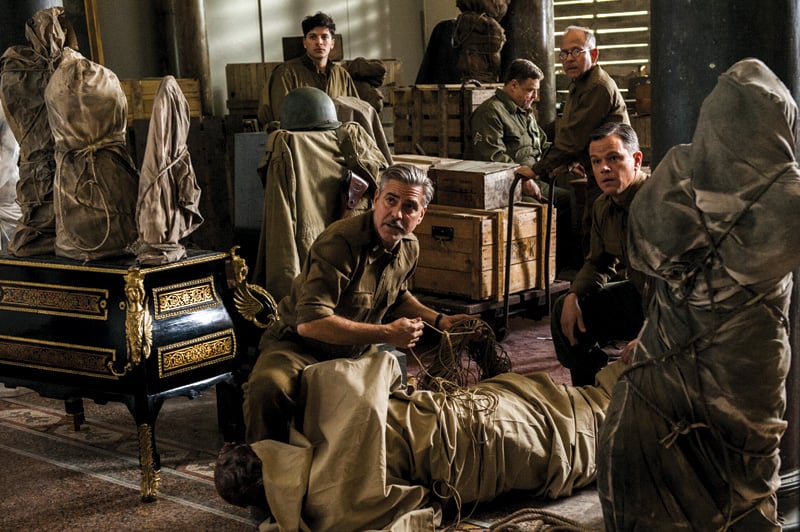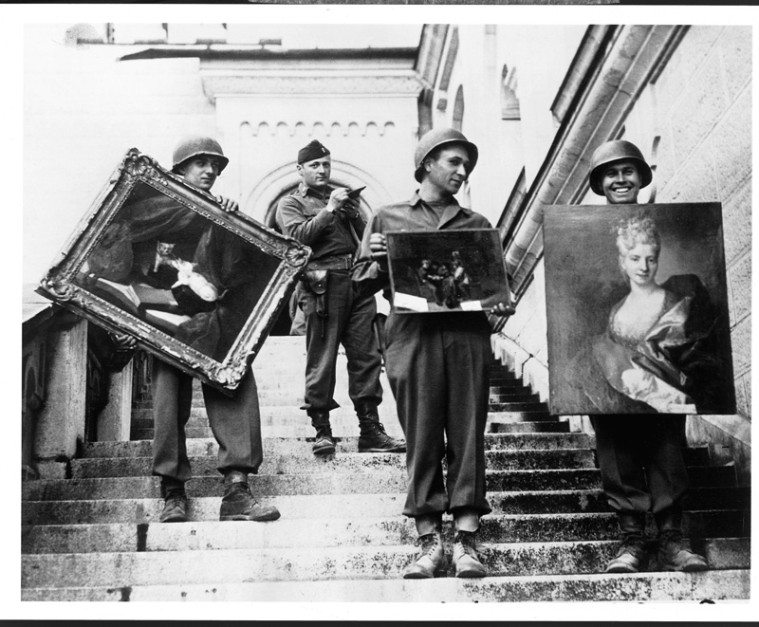
The Lost Art of The Monuments Men
A version of this story ran in the December 2013 issue.
Above: From left to right, Sam Epstein, George Clooney, John Goodman, Bob Balaban and Matt Damon in The Monuments Men.
Dallas oilman-turned-author Robert Edsel has great expectations for George Clooney’s adaptation of his book, The Monuments Men. “I’m not interested in 100,000 people or a million people knowing the story,” Edsel says. “I want a half-billion people around the world to know it. Nobody can write a book that can do that, but a feature film can do it, and this film I think’s going to do it.”
Based on accounts of the Allies’ attempts to locate and recover artworks stolen by the Nazis during World War II, The Monuments Men was initially scheduled for a December release, then delayed, and will now premiere at the Berlin International Film Festival in February. The Berlin festival’s endorsement came just a week after a German magazine broke the news of a massive trove of lost art discovered in the Munich apartment of a well-known Nazi art dealer’s son; languishing in a dingy room were works by Picasso, Chagall, Matisse and others, collectively valued at $1.3 billion. It is the largest discovery of apparently Nazi-looted art to date, and the story was apparently leaked—the German government has been sitting on the information for nearly two years, but wasn’t prepared to deal with the inevitable media frenzy. German officials have offered the press no inventory of the artworks, no documentation of the paintings’ provenance, and no information about when or if the 80-year-old hoarder, still free, might be taken into custody. The situation is not only embarrassing for Germany; it portends a legal, financial and logistical nightmare. Many of the works are believed to have been stolen from Jewish families. Germany’s government expects a tidal wave of restitution claims to soon be filed by Holocaust survivors and their heirs all over the world. The film’s sudden appearance on the festival’s schedule after previous delays now seems either an awkward coincidence or a stroke of PR genius.
Edsel may be exaggerating when he targets the film’s audience at half a billion, or maybe he’s just misinformed about the movie business (the most profitable film in history, Avatar, attracted fewer than 100 million viewers worldwide, according to box-office figures), but the film’s prospects are still relatively good. Clooney co-wrote, produced, directed and stars in the $50 million production with an ensemble cast including Matt Damon, Cate Blanchett, Bill Murray, John Goodman and Jean Dujardin. The plot seems tailor-made for Hollywood: During World War II, a ragtag team of teenage draftees and middle-aged volunteer art conservators are sent to protect or recover Europe’s monuments, art and archives from the ravages of combat. In the process they uncover a scheme, personally masterminded by Hitler, to steal the greatest art of Europe—Michelangelos, da Vincis, Vermeers and more. Armed with woefully inadequate resources, these “Monuments Men” discover missing masterpieces in salt mines, caves and castles, often booby-trapped with dynamite.
An autodidact with a full-time staff of researchers, Edsel has managed to become an expert in an area in which he has no formal training or academic credentials. He has published three books, including the recent New York Times bestseller Saving Italy: The Race to Rescue a Nation’s Treasures From the Nazis (W.W. Norton, 2013), and spends six to eight months a year traveling to speaking engagements. According to his agency, the Greater Talent Network Speakers Bureau, his fee is in the neighborhood of $20,000 per event. He holds theatrical and video distribution rights to Actual Films’ Rape of Europa documentary, and has repurposed segments of that film as a subscription-based classroom educational product called The Greatest Theft in History Educational Program.
Edsel’s oil money, patriotic perspective, emotional prose and immodest personality do not endear him to peers in the field. Nor does his penchant for stressing the dearth of information about the Allied Armies’ recovery of stolen work. As he writes in the introduction to The Monuments Men, “What if I told you there was a major story about World War II that hasn’t been told, a significant story at the heart of the entire war effort, involving the most unlikely group of heroes you’ve never heard of?” In fact that story has been well researched and documented by historian Lynn Nicholas, the Washington, D.C.-based author of The Rape of Europa: The Fate of Europe’s Treasures in the Third Reich and Second World War, which won the National Book Critics Circle Award for nonfiction in 1994. The story was told again in 2006, in the documentary film based on Nicholas’ book. It aired on PBS and was nominated for two Emmy Awards. Edsel was a co-producer and distributor of that film. What he presumably means by “untold” is “told to an insufficiently large audience.”

Edsel has an inborn impatience with the scholarly process. “Academics have to find a way to communicate with average people, or else you’ve got the same club of people listening to your message, reading your dissertations,” he says. To that end, The Monuments Men reads like a movie script. Edsel invents dialogue, facial expressions and inner thoughts for his factual characters; they’re constantly shuddering and clapping each other on the back—descriptive liberties that Edsel justifies with the explanation that they are extrapolated from the Monuments Men’s personal papers and letters. At its core, Edsel’s book is a narrative about the triumph of good over evil. His protagonist is Harry Ettlinger, a German Jew who, at age 13, had to postpone his bar mitzvah to flee to the United States with his family. A few years later Ettlinger was drafted into the U.S. Army, where he served as a Monuments Man and later returned home to New Jersey as a decorated veteran.
In 2007 Edsel established a not-for-profit organization, the Monuments Men Foundation for the Preservation of Art, which was awarded a National Humanities Medal by President George W. Bush the same year. Edsel describes the foundation’s mission as threefold: to “honor the legacies” and contributions of the Monuments Men to cultural preservation; to “reestablish a high bar for the protection of cultural treasures”; and to “sound the gong for people all over the world who may have missing works of art or things that were taken as souvenirs during the war.”
The search for art displaced during World War II has been a subject of growing public interest and legal dispute for the past two decades, as Nicholas and other scholars have situated Nazi art theft in an international context. Hitler, a failed artist and ravenous collector of paintings, masterminded the most elaborate and bureaucratic scheme of art looting in history. According to his plan, all “exemplary” art would be collected in a grand museum in his hometown of Linz, Austria, while “degenerate” material would be purged from the Reich and sold for foreign currency. Renaissance masterpieces were ransacked from Paris’ Louvre and destined for Linz. Special police squads seized art from the private collections of Jewish families. “Degenerate” works of modernism were removed from German museums and sold to Swiss dealers and on the gray market. Some of these works, like those discovered in Munich, were secretly squirreled away by German collectors. Many ended up in the permanent collections of the world’s great museums, which often turned a blind eye to their provenance. Tracing such byzantine patterns of ownership in hopes of returning stolen works to the heirs of their former owners is a matter of meticulous detective work.
In the past decade, American museums have been taken to task for failing to do that work. New York’s Museum of Modern Art has repeatedly been a defendant in restitution cases, including one regarding Egon Schiele’s 1912 Portrait of Wally (the subject of a 2013 documentary of the same title by University of Texas professor Andrew Shea). In the spirit of transparency, the American Association of Museums and related organizations have compiled an online database of works of questionable provenance—“objects that changed hands in Continental Europe during the Nazi era”—called the Nazi-Era Provenance Internet Portal (www.nepip.org). A search of the registry yields some troubling results here in Texas: Fort Worth’s Kimbell Art Museum is in possession of 72 works of uncertain origin; the Dallas Museum of Art houses 188 such works. These holdings pale in comparison to the permanent collection of the University of Texas’ Blanton Museum of Art, which contains more than 600 works lacking provenance information from 1933 to 1955, the primary period of looting and displacement.
Edsel made national headlines in 2010 when he discovered proof of Nazi theft in the cases of two 17th century Spanish paintings at the Meadows Museum at Southern Methodist University, his alma mater. The works bore Nazi inventory codes on the backs of their canvasses—definitive evidence that they had been confiscated from the Jewish Rothschild family in Paris. Though SMU has produced provenance documents showing that the works came into the collection through a legal auction purchase, the taint of Nazi interference remains.
The day I visited the Dallas headquarters of the Monuments Men Foundation, a tastefully converted warehouse amid new art galleries and old factories, Edsel was wearing jeans, a T-shirt, Nike running shoes and day-old stubble. At 56 he is fit, wiry and tall, with a white head of hair that belies his wide-eyed enthusiasm. The son of a stockbroker who served in the Pacific during WWII, Edsel played tennis and majored in finance at SMU. In the early 1980s he entered the oil and gas business with his brother, Jim, who had studied petroleum land management at the University of Texas. Together, the Edsel brothers founded the Gemini Exploration Company (a pun on “Jim and I”), one of the first Texas upstarts to successfully exploit newly developed horizontal-drilling technologies in the notoriously unproductive “Austin chalk” oilfields of Bastrop, Giddings and La Grange. At its peak, Gemini had 100 employees.
“It became a big, big business, and I like building things, I don’t like running things,” Edsel says now. In 1995 he cashed out, selling his stake in Gemini to Union Pacific Resources Group for $35 million. A year later he and his wife, jewelry designer Brenda Schoenberg (they divorced in 2000), and son, Diego, left for an extended vacation to Italy. They rented homes in various cities and towns, finally deciding to stay a while in Florence.
Growing up, he’d had no particular interest in art, but that changed during his European quasi-retirement. “I felt like, ‘Well, I can’t be in Florence and not learn about art and architecture,’” he says. So he hired an art history professor to take him on private walking tours of the city, one day a week, for what turned out to be six years. The living history of Florence’s cultural riches made him curious about how so many of the city’s great paintings, frescoes and statues had survived the devastation of WWII. His tutor referred him to Nicholas’ book, and Edsel says he had a sort of revelation: The Allies not only won the war, they saved Europe’s cultural patrimony. He could immediately see that story on the big screen. Thus began what he calls his 10-year “quest” to make a feature film. “A lot of it was a leap of faith, like that great scene from Indiana Jones where he’s going to stick his foot out, there’s nothing there.”
Nicholas told me that Edsel contacted her publisher about buying the movie rights to The Rape of Europa around 2001. Actual Films’ Richard Berge, Bonni Cohen and Nicole Newnham had already begun filming the documentary at that point, but they were struggling with financing. Berge says they’d raised 75 percent of their budget from foundation sources, including the National Endowment for the Arts and the National Endowment for the Humanities, but were having trouble getting any further, and the foundations weren’t willing to unlock the grants unless they came up with matching money. The filmmakers needed a private investor. Enter Robert Edsel.
There were strings attached. Berge says Edsel offered finishing funds, about 25 percent of the documentary’s million-dollar budget, in exchange for a co-producer credit, full distribution rights, ownership of all outtakes from the film, and access to Actual Films’ research, including source contacts, archival documents and photographs. Berge knew that Edsel was working on a self-published photo book, Rescuing da Vinci, as a companion piece to the film, but he wasn’t aware that Edsel was planning to write The Monuments Men. “He took all that work and ran with it for the next two books,” Berge says now. Nicholas says Edsel also purchased an option to make a fictionalized film of The Rape of Europa in 2005 and renewed the agreement in 2007—the same period when Edsel was shopping the movie rights to his own book.
Berge and Nicholas are careful to emphasize that they are not charging Edsel with intellectual theft, but with excess opportunism. According to Berge, “Edsel has approached the subject not with a spirit of intellectual openness and collaboration, but with the narrow, proprietary approach of a businessman who seemingly wants to corner the market as the public poster boy for Nazi art-looting history. For heaven’s sake, why does he feel the need to put down scholars who have dedicated time and great effort to broadening our understanding of this history?”
All parties agree that the Monuments Men and their work should be celebrated. How, and who should get credit for doing so, remain points of contention.
Maybe George Clooney can bridge the gaps.


